How to store garlic?
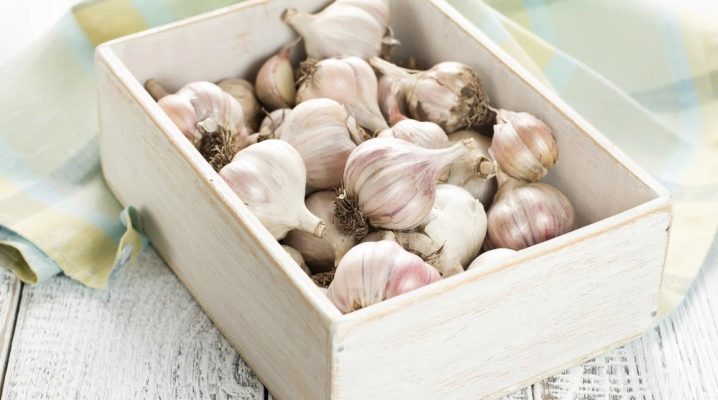
After harvesting, each gardener tries to take care of the safety of the grown products. Garlic at home can be stored both in a cellar and in a house or in a city apartment. The main thing is to provide him with suitable storage conditions.
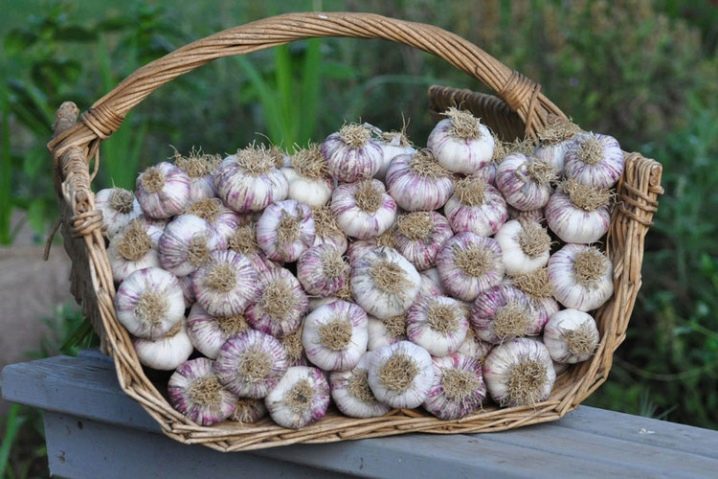
Preparation
After digging up the garlic, it is important to prepare it properly. First of all, you need to understand when is the best time to harvest. Spring garlic is dug out at the very beginning of August. Do this after the arrows turn yellow and begin to bend to the ground. Winter garlic is harvested at the end of July. Cleaning is necessary in dry cloudy weather. If possible, it is best to do this in the evening.
Dig up the plants carefully. Young heads are easily damaged. In this form, they are not stored as long as we would like. To prevent this from happening, the soil is first undermined with a pitchfork. Only after that the culture is gently pulled out of the ground. Then the garlic is cleaned of dirt and sent to dry. To do this, it is left in a warm and dry room for 3-4 days. If the weather is good, you can dry the garlic outdoors. In this case, it is laid out under a canopy and stored for 4-5 days.
After drying, the crop is sorted out. All heads with traces of damage or disease are removed. It is advisable to eat such garlic in the near future. The rest of the products can be sent for storage.
To keep garlic from spoiling for a longer time, some of its varieties must be stored in different containers.
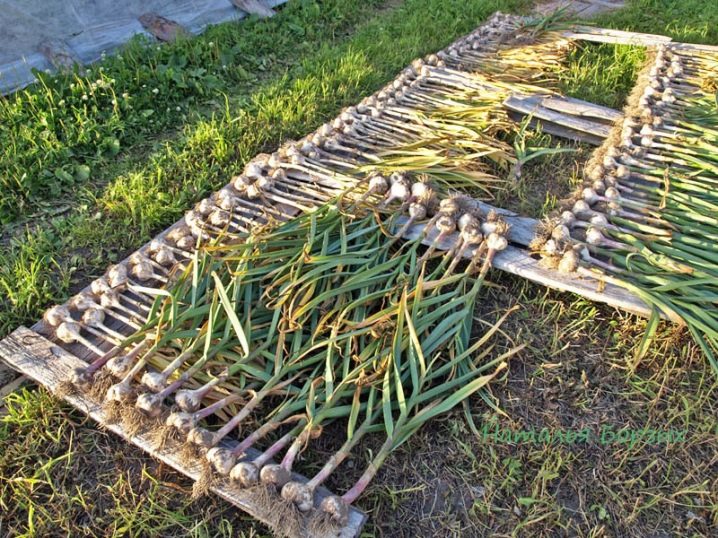
Storage methods for whole heads
Whole heads are usually stored in a cellar, basement, closet, or on a glassed-in balcony. To prevent the garlic from drying out and starting to rot, it is important that the room temperature is correct. They are best kept at 5-7 degrees. It is also important to protect the harvested product from direct sunlight.
There are several basic ways to store garlic.
- In the ash. In this form, garlic can be stored for about six months. At the same time, it will not deteriorate and rot. Any drawer of a suitable size is suitable for storage. Its bottom should be covered with newspaper sheets. Next, you need to pour a layer of ash on the paper. It shouldn't be too thin. The heads are placed in the ash with their tails down. Place them next to each other. After that, the garlic is covered with another layer of ash. The harvest box is sent to the selected storage.
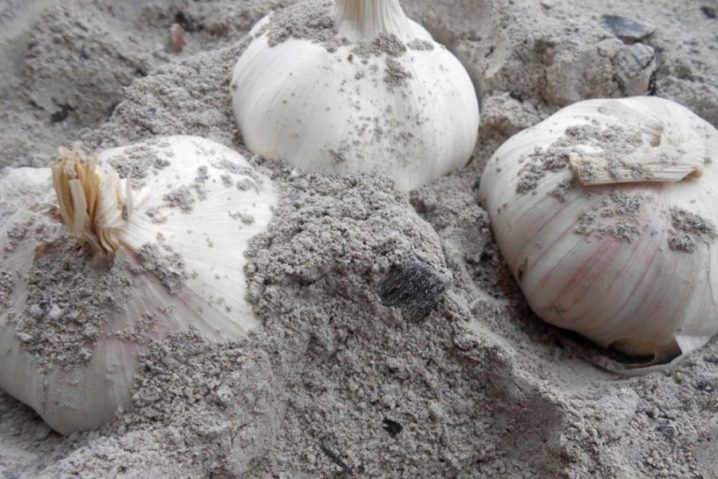
- In baskets. You can save garlic until winter by placing it in small wicker baskets or plywood boxes. The selected container is filled to the very top. Keep garlic baskets away from other vegetables. Do not let it lie next to beets, cabbage or potatoes. In addition, garlic stored in baskets should be sorted from time to time.

- In the ground. If there are no other options, the harvested crop can be folded into a hole dug right in the garden. In this form, it can be stored until the first frost. Fresh garlic should be folded in a plastic bag and wrapped in paper. After that, it is placed in the well. Top garlic with a layer of soil and dry foliage. The place where the harvest is buried is worth marking. In this case, there will be no problems with finding it.
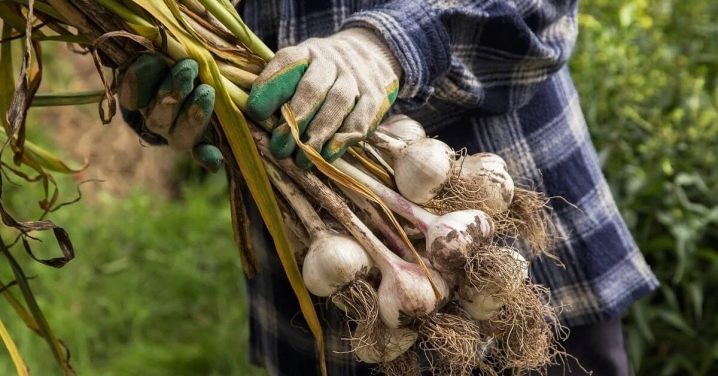
- In braids. This is one of the oldest ways to store garlic. To weave braids easily, you do not need to cut off the tops from the garlic heads. The harvested crop must be sent to dry. After a few days, you can start braiding.To make them more dense, metal rods or wire are used as a frame. The upper part of the braid is neatly folded over. For the resulting hook, it will be easy to hang them anywhere. To prevent the braid from falling apart at the most inopportune moment, its edge must be carefully tied with twine. Unnecessary foliage debris should be removed. You can store such garlic braids on the veranda, in the cellar or on the balcony.
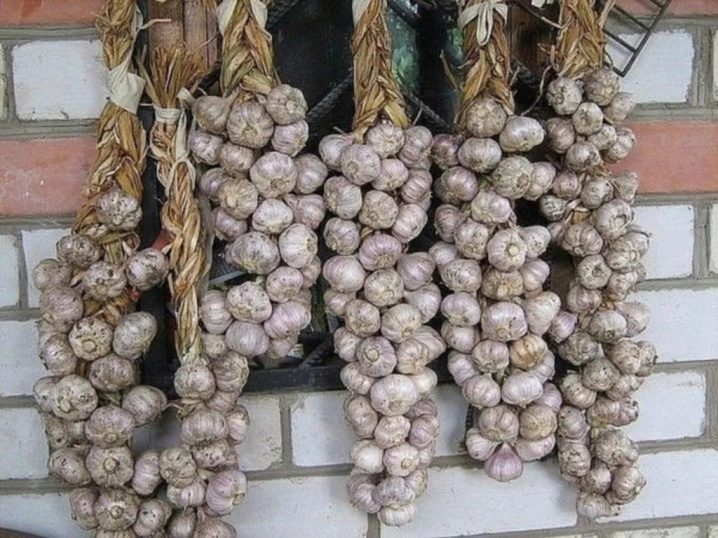
- In a bundle. This method is similar to the previous one. But individual stems do not need to be intertwined. It is enough to tie them with twine. Next, the resulting bundle must be hung in the attic, in the shed or in the closet.
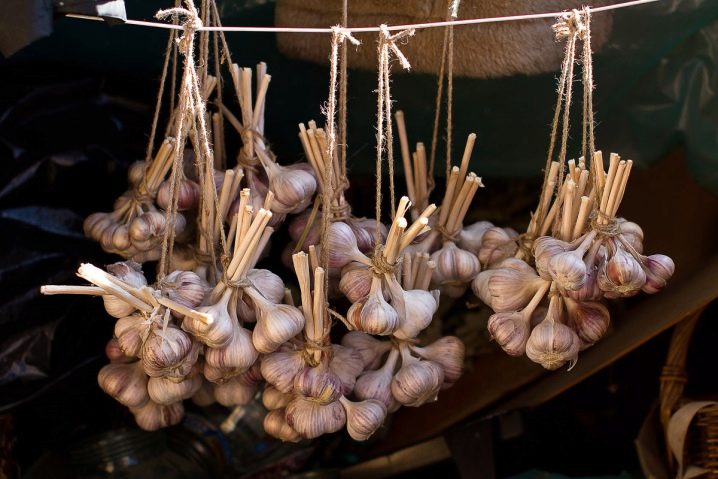
- In dry hay. You can save the garlic until the next harvest by placing it in a box with hay. The container should also be prepared in advance by covering it with newspapers. Then put the dried grass on the bottom. Dry garlic heads can be placed in it. It is very important that they do not touch each other. Having finished with this process, the box should be covered with newspapers and sent to the basement. In such conditions, garlic does not rot or dry for a long time.
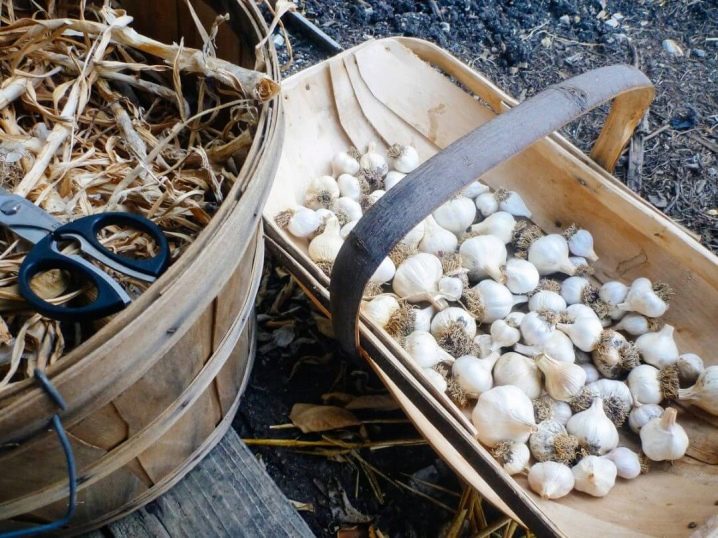
- In sawdust. This material, like hay, helps preserve the harvest until spring. The way of storing the crop is the same. The box is filled with dry sawdust. After that, garlic heads are placed in a container. They are located at a short distance from each other. After that, the box of garlic is stored in any cool place. Dry onion husks can be used instead of sawdust. It also perfectly protects garlic from excess moisture.

- Banks. Small amounts of garlic can also be stored in jars. First, you need to rinse the jars with soda, cut the garlic and sort by size. Then it is placed in prepared jars. They must be completely filled with garlic. The neck is tied with gauze or a piece of cloth. After that, the jar is moved to a dark cabinet or closet. Do not close containers with tight lids. This will lead to the fact that the crop will quickly deteriorate.
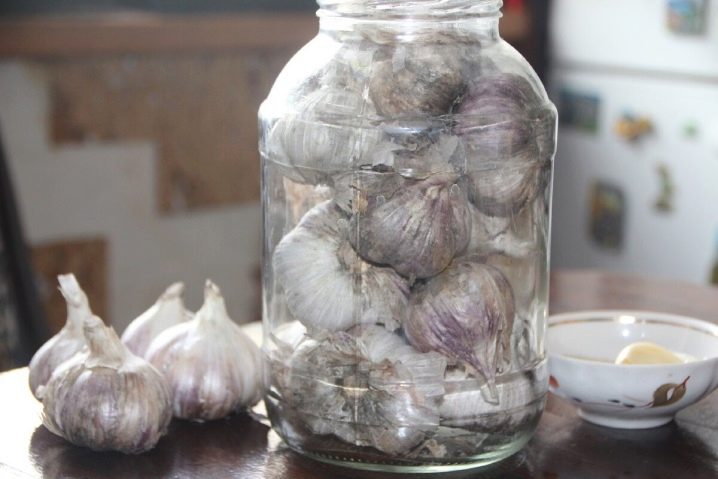
- In cloth bags. This method is suitable for storing garlic in an apartment. You need to fold the crop in bags made of natural fabric. To extend the shelf life, they are soaked in saline in advance, and then dried well. This helps prevent the risk of mold or disease. You can store garlic in such bags both on the balcony and in ordinary kitchen drawers.

Garlic in the heads is stored for a long time. Therefore, gardeners do not have to worry about the harvested crop.
How to preserve individual teeth?
You can also store peeled garlic at home. But for this it is important to take care of the correct processing of the cloves.
Vacuum packed
If you have a simple vacuum sealer in your home, you can store the fragrant cloves in a vacuum. In such conditions, the product will not deteriorate within 10-14 months. Peeled garlic cloves must be folded into vacuum bags. They must be dry. Vacuum packed garlic is usually kept in the refrigerator.
Instead of vacuum packaging, the cloves can be wrapped in cling film. But in this form, the product will not be stored for so long. Before wrapping the garlic with cling film, it must be dried very well. Otherwise, it will quickly deteriorate. You need to wrap the cloves with several layers of film. In this case, the smell will not spread through the refrigerator.
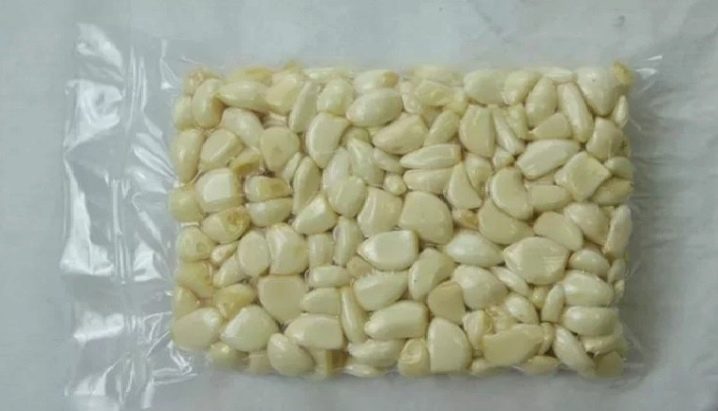
In salt
Individual cloves can also be stored in jars of table salt. The containers are filled with garlic and sprinkled with a small amount of salt. The container must be filled to the brim. Next, the jar needs to be closed with a lid. After that, the workpiece can be removed to the pantry or refrigerator. Since salt perfectly absorbs moisture and odors, garlic can be stored in this form for a very long time without losing its taste.
Instead of salt, you can also add rice or flour to the jar. But this way of storing the crop is not so profitable.
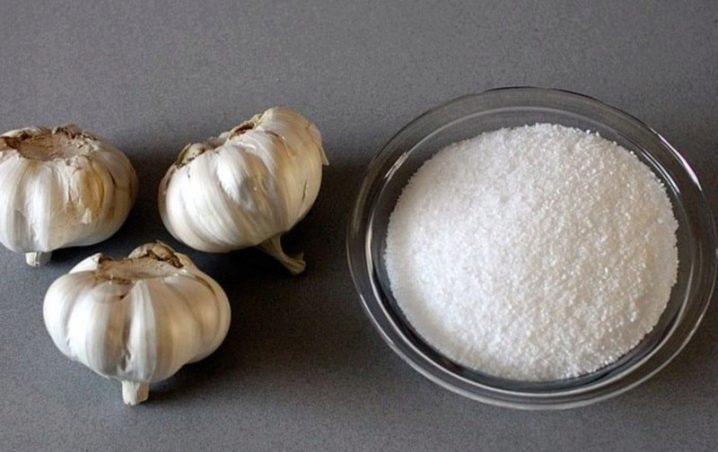
Dried
To avoid taking up a lot of space, garlic can be used to make seasonings. In this form, the spice will be stored for a very long time. Preparing garlic seasoning is quite simple. The slices are peeled and crushed using a blender. Next, the resulting mass is sent to dry. The layer should be very thin. In this case, the garlic will dry out quickly. The fragrant seasoning will be ready in a couple of days. It only remains to pour it into a small container or paper bag. Store dried garlic in a warm and dry place.
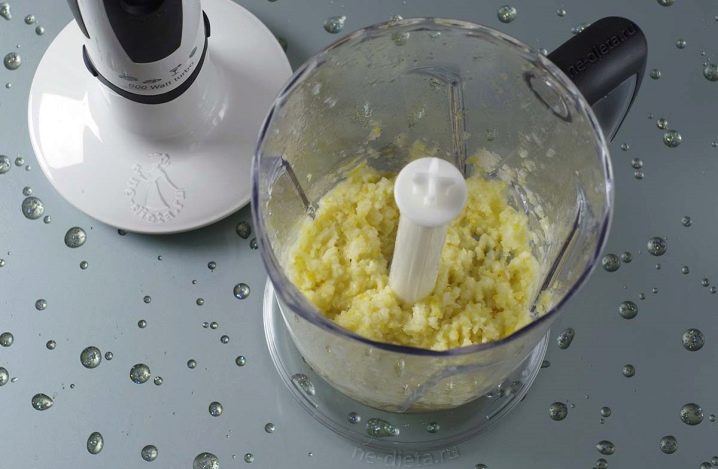
In fridge
A small amount of garlic can be stored simply on the shelves of the refrigerator. There it does not disappear and does not lose its taste attractiveness. To preserve the garlic better, it must be dried well in advance, and then put in a clean container. There it will be stored from several weeks to several months.
Some gardeners prefer to process the garlic with paraffin after harvest. In this case, it does not rot, yellow or mold. It is very easy to process garlic with paraffin. First of all, you need to clean the teeth and dry them well. After that, the paraffin must be cut into small pieces and dipped in each individual wedge. This can be done using simple tweezers.
The product prepared in this way must be laid out on a newspaper sheet. When the paraffin is dry, the cloves should be folded into a jar or container and placed in the refrigerator.
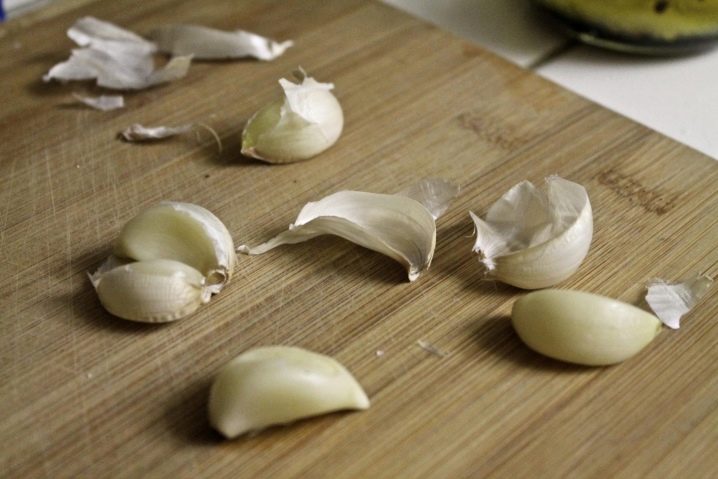
In the freezer
You can increase the shelf life of garlic by sending it to storage in the freezer. Freezing does not affect the taste of the product in any way. Plus, it doesn't get any less useful. You can freeze whole garlic or chopped into cubes. It is usually placed in small plastic containers or bags.
Some housewives grind the product with a meat grinder or blender, and then put it in ice molds. It is very convenient to use garlic frozen in this way. You can add such products to food without defrosting it first.
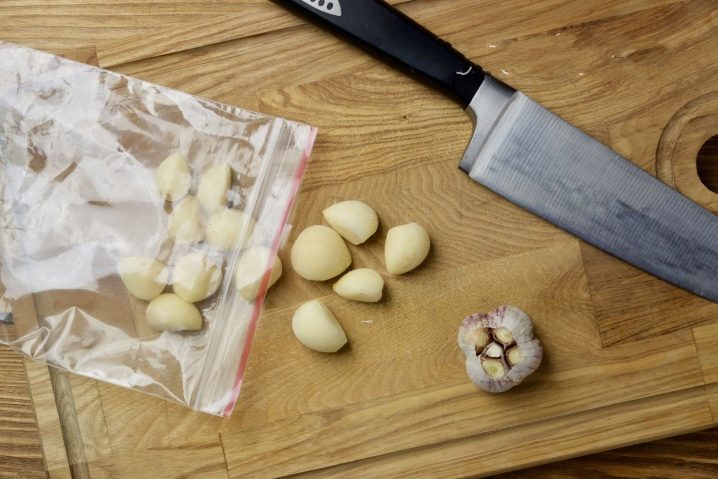
In blanks
Garlic is also perfectly stored in a container with vegetable oil. The cloves do not deteriorate over time, and the oil is saturated with a pleasant aroma. Therefore, it can be further used for cooking various dishes or dressing salads.
Harvesting garlic in this way is very simple. First, the heads need to be disassembled into separate teeth. After they need to be peeled off. Glass containers must be washed, dried and sterilized. Next, cloves of garlic should be placed in the jars. They must be filled with any vegetable oil. It should completely cover the teeth. Next, the jar must be closed with a lid. Some people add small amounts of black pepper and aromatic herbs to each container. This only improves the taste and smell of the harvested product.
It is worth storing such blanks in the basement or in the pantry. After opening the jars, the garlic should be consumed within the next few weeks.
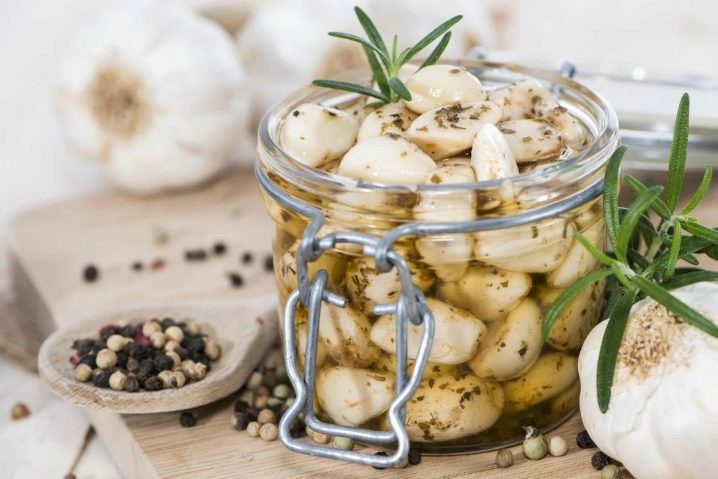
Frequent mistakes
When sending products for storage, some gardeners may face various problems.
- Drying. If the heads or teeth dry too quickly, the air in the room is very dry. This situation can be corrected by regularly ventilating the room. If this is not possible, the garlic must be peeled and frozen or preserved.
- Rotting products. Traces of mold or rot on the harvested crop appear if the room is too humid or too hot. Noticing that the garlic begins to deteriorate, the cloves with traces of damage must be removed from the storage place and processed. The rest of the garlic should be moved to a dry place with lower humidity or frozen.
- Germination. This usually happens 4-5 months after harvesting the garlic. To prevent this from happening, the room temperature should not be too high. Sprouted garlic must also be sent for processing.If it is not possible to use it in cooking, the cloves can be dried or frozen.
- The appearance of yellow spots. If the cloves start to turn yellow, it's time to go over the stocks. Contaminated products must be separated from healthy ones. Crop residues should be checked regularly.
In general, garlic is one of those foods that have a very long shelf life. Therefore, gardeners can use the harvested crop for many months in a row.
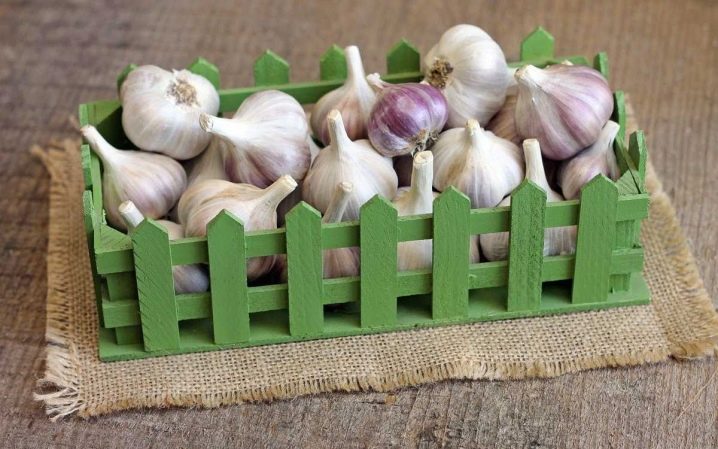








The comment was sent successfully.